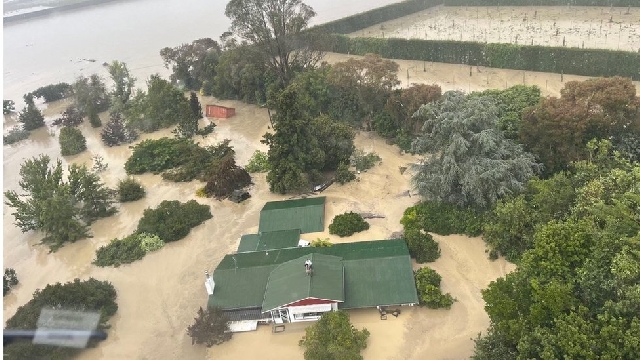Cyclone Gabrielle: Hundreds rescued from rooftops as New Zealand grapples with damage
 Soldiers in helicopters winched people to safety from the rooftops in the Hawke's Bay area
Soldiers in helicopters winched people to safety from the rooftops in the Hawke's Bay area
New Zealand officials say at least four people, including a child, have died in the devastation of Cyclone Gabrielle, which has caused significant flooding and landslides across the North Island.
On Wednesday, officials confirmed a child's body was found in Hawke's Bay, one of the worst-affected regions.
Rescue helicopters there had rescued about 300 people stranded on rooftops.
The cyclone has moved away from New Zealand but about 10,500 people were still displaced on Wednesday.
Prime Minister Chris Hipkins on Wednesday evening said there were also "several people missing for whom the police do hold grave concerns."
While the rain has ceased in most parts, many remote towns and areas remain cut off by high floodwaters and a lack of power.
New Zealand's prime minister Chris Hipkins has called Gabrielle the biggest weather event to hit the country in the past century. It's estimated to affect at least a third of the country's five million population.
The storm's damage has been most extensive in coastal communities on the far north and east coast of the North Island - with areas like Hawke's Bay, Coromandel and Northland among the worst hit.
The situation in Hawke's Bay, a popular tourist destination with some remote towns, was of particular concern to authorities, said Emergency Management Minister Kieran McAnulty.
As the cyclone hit on Monday night, residents in Hawke's Bay had been forced to swim through bedroom windows as the water level rose.
"In some cases, flood waters were up to the second storey of homes where people were being rescued," a military spokesperson said.
At least three people have died in the area. One woman was killed in a landslide at her home, while another person was found dead on the shoreline, authorities said. Police said they believed the child was caught in rising water.
The body of a missing firefighter who had been caught in a landslide in west of Auckland was also found on Tuesday.
Mr McAnulty on Wednesday said it would be unsurprising if the death toll rose further.
But he hailed the "phenomenal" effort of rescue workers who plucked "roughly 300 people from rooftops" in Hawke's Bay, with 60 people rescued from one large building marooned by floodwaters.
On Wednesday, more than 140,000 people across the island were still without power, although electricity had been restored to 80,000 homes.
Residents in hard-hit areas are also being asked to conserve water and food because of fears of shortages.
New Zealand announced a national state of emergency on Tuesday, which allows it streamline its response to the disaster.
The country has only previously declared a national state of emergency on two occasions - during the start of the Covid-19 pandemic and following the 2011 Christchurch earthquake.
New Zealand's climate minister has attributed to the scale of the disaster to climate change.
"The severity of it, of course, [is] made worse by the fact that our global temperatures have already increased by 1.1 degrees," said James Shaw in parliament on Tuesday.
"We need to stop making excuses for inaction. We cannot put our heads in the sand when the beach is flooding. We must act now."
Cyclone Gabrielle hit New Zealand's North Island just two weeks after record downpours and flooding in the same region. Four people died in those floods.
Source: BBC
Trending World

Trump says US to lift Syria sanctions, secures $600 billion Saudi deal
22:11
'El Chapo' & 'Deputy Jesus': Why Kenya's president has so many nicknames
20:21
Military rulers in Mali dissolve all political parties
20:10
Human rights groups warn of 'surge' in migrant worker deaths in Saudi Arabia
20:07
Peru's prime minister resigns ahead of no-confidence vote
20:03
Times reporter who exposed grooming gangs in UK dies
19:56
India disputes Trump claim it is ready to charge US 'no tariffs'
19:15
Iran using criminal gangs for hit jobs abroad, court papers show
17:09
US and Iran close to nuclear deal, Trump says
19:02
Gambia probes sale of ex-leader's luxury cars, cows and boats
19:10




